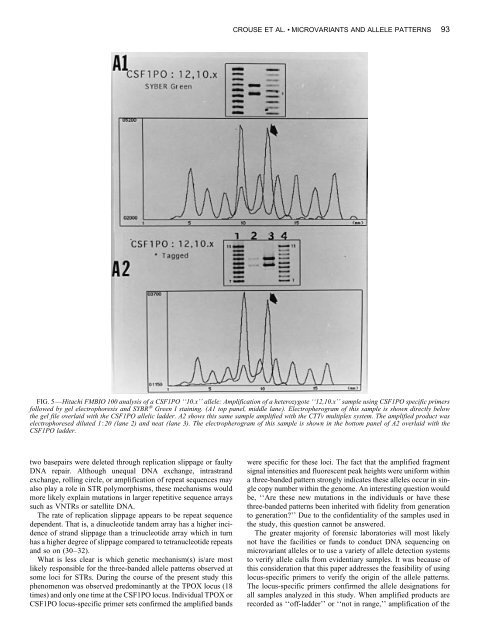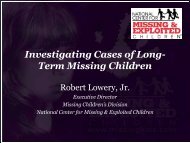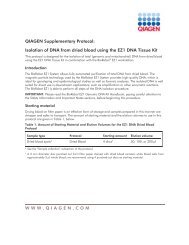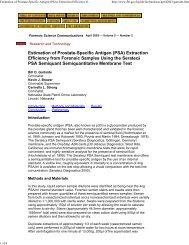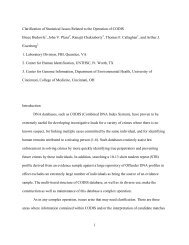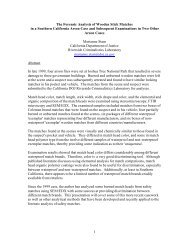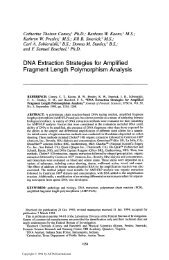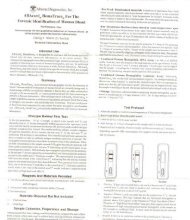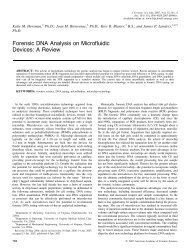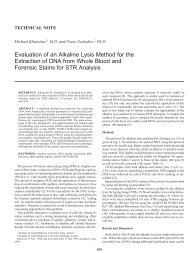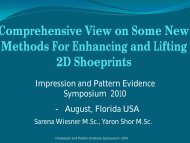Analysis and interpretation of short tandem repeat microvariants and ...
Analysis and interpretation of short tandem repeat microvariants and ...
Analysis and interpretation of short tandem repeat microvariants and ...
Create successful ePaper yourself
Turn your PDF publications into a flip-book with our unique Google optimized e-Paper software.
CROUSE ET AL. • MICROVARIANTS AND ALLELE PATTERNS 93FIG. 5—Hitachi FMBIO 100 analysis <strong>of</strong> a CSF1PO ‘‘10.x’’ allele: Amplification <strong>of</strong> a heterozygote ‘‘12,10.x’’ sample using CSF1PO specific primersfollowed by gel electrophoresis <strong>and</strong> SYBR ® Green I staining. (A1 top panel, middle lane). Electropherogram <strong>of</strong> this sample is shown directly belowthe gel file overlaid with the CSF1PO allelic ladder. A2 shows this same sample amplified with the CTTv multiplex system. The amplified product waselectrophoresed diluted 120 (lane 2) <strong>and</strong> neat (lane 3). The electropherogram <strong>of</strong> this sample is shown in the bottom panel <strong>of</strong> A2 overlaid with theCSF1PO ladder.two basepairs were deleted through replication slippage or faultyDNA repair. Although unequal DNA exchange, intrastr<strong>and</strong>exchange, rolling circle, or amplification <strong>of</strong> <strong>repeat</strong> sequences mayalso play a role in STR polymorphisms, these mechanisms wouldmore likely explain mutations in larger repetitive sequence arrayssuch as VNTRs or satellite DNA.The rate <strong>of</strong> replication slippage appears to be <strong>repeat</strong> sequencedependent. That is, a dinucleotide t<strong>and</strong>em array has a higher incidence<strong>of</strong> str<strong>and</strong> slippage than a trinucleotide array which in turnhas a higher degree <strong>of</strong> slippage compared to tetranucleotide <strong>repeat</strong>s<strong>and</strong> so on (30–32).What is less clear is which genetic mechanism(s) is/are mostlikely responsible for the three-b<strong>and</strong>ed allele patterns observed atsome loci for STRs. During the course <strong>of</strong> the present study thisphenomenon was observed predominantly at the TPOX locus (18times) <strong>and</strong> only one time at the CSF1PO locus. Individual TPOX orCSF1PO locus-specific primer sets confirmed the amplified b<strong>and</strong>swere specific for these loci. The fact that the amplified fragmentsignal intensities <strong>and</strong> fluorescent peak heights were uniform withina three-b<strong>and</strong>ed pattern strongly indicates these alleles occur in singlecopy number within the genome. An interesting question wouldbe, ‘‘Are these new mutations in the individuals or have thesethree-b<strong>and</strong>ed patterns been inherited with fidelity from generationto generation?’’ Due to the confidentiality <strong>of</strong> the samples used inthe study, this question cannot be answered.The greater majority <strong>of</strong> forensic laboratories will most likelynot have the facilities or funds to conduct DNA sequencing onmicrovariant alleles or to use a variety <strong>of</strong> allele detection systemsto verify allele calls from evidentiary samples. It was because <strong>of</strong>this consideration that this paper addresses the feasibility <strong>of</strong> usinglocus-specific primers to verify the origin <strong>of</strong> the allele patterns.The locus-specific primers confirmed the allele designations forall samples analyzed in this study. When amplified products arerecorded as ‘‘<strong>of</strong>f-ladder’’ or ‘‘not in range,’’ amplification <strong>of</strong> the


